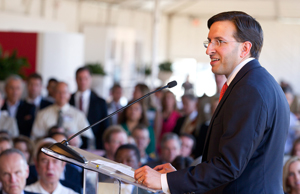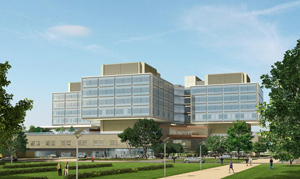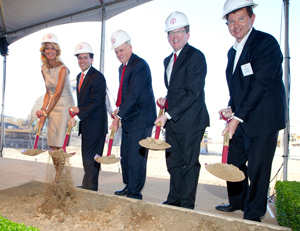May 1, 2013 - By Ruth Schechter

Staff from Stanford Hospital's intermediate intensive care unit attend a groundbreaking celebration for employees May 2 at the site of the new hospital building. A groundbreaking ceremony attended by Stanford Medicine leaders, donors and others was held there the previous day.
For Chis Bowers, the construction workers, dump trucks and diggers around Stanford Hospital & Clinics are a vivid reminder of what the hospital renewal project is all about: caring for patients.
Diagnosed with cancer in 2009, Bowers was one of the speakers at today's groundbreaking ceremony for the new hospital. He credits Stanford with saving his life. "It is my privilege and honor to speak for the patients this afternoon," said Bowers, a resident of Los Altos Hills. “I was diagnosed, treated at Stanford, and I survived. I am thankful to the people at Stanford who healed me and am happy to be part of what this event will mean to future patients.”
About 400 administrators, donors and community members gathered under an enormous white tent to watch as shiny red shovels were put to ceremonial dirt, marking the formal start of construction and a new chapter in the history of Stanford Hospital & Clinics. Attendees looked out through a clear-paneled wall of the tent onto the excavation site, where immense yellow diggers and bulldozers stood motionless for the evening.

Amir Dan Rubin, president and CEO of Stanford Hospital & Clinics, speaks at the groundbreaking ceremony May 1.
"Our vision here at Stanford Hospital & Clinics is to heal humanity, through science and compassion, one patient at a time," said Amir Dan Rubin, the hospital's president and CEO. "The hospital is embedded in the university, collaborating with engineering, computer science, law, and it’s embedded in Silicon Valley. These collaborations are part of what I call the ‘Stanford edge,’ and part of our commitment to heal with comfort, compassion and service.”
Scheduled to open to patients in 2018, the new building will optimize the hospital's services and infrastructure, adding more beds, private rooms, state-of-the-art operating suites, expanded emergency services and the flexibility the hospital needs to adapt to advancing technologies and more streamlined services.
The new 824,000-square-foot hospital will increase patient capacity to 600 beds and feature 368 individual patient rooms, an enlarged level-1 trauma center and an emergency department nearly three times the size of the current capacity. Designed by the internationally recognized firm Rafael Viñoly Architects, the project will feature amenities intended to enhance both physical and emotional healing with the latest in medical, surgical and diagnostic technology. The new building will be connected to the current hospital by a bridge and tunnel. [View a video about the hospital's construction.]

Slated to open in 2018, the new hospital will feature individual patient rooms with expansive windows that provide natural light and integrated accommodations for family members to visit and spend the night.
The new hospital will feature individual patient rooms centered on health and well-being, with expansive windows that provide natural light and integrated accommodations for family members to visit and spend the night. Patient rooms will be modular, allowing them to accommodate any level of acuity. A roof garden setting will create a quiet retreat for patients and families, and landscaping will feature native and drought-tolerant plants. The building also incorporates the latest innovations in green technology to reduce the hospital's environmental impact.
"Advancing and utilizing science is one of the core values of this university, and this hospital will help to build on that tradition,” said Stanford University President John Hennessy. “In 1959, the hospital we have now was groundbreaking, but that was in 1959. To deliver the high-quality medical care that people expect today, we need to move forward. The new Stanford Hospital will serve the local community, even as its benefits are felt well beyond it — in excellent patient care, the development of innovative therapies and treatments, and the education of tomorrow’s health-care leaders.”

The crowd of 400 listens to remarks by Stanford University President John Hennessy.
Though the hospital has been in operation for decades, its current building was constructed in 1959 and cannot be brought up to state-mandated seismic standards. In addition, technology has changed dramatically since then, as have the needs of the patients who come to the hospital for care.
Construction of the new hospital is part of the $5 billion Stanford University Medical Center Renewal Project that will bring facilities to current seismic safety standards and support the growth of the medical center, which comprises Stanford Hospital & Clinics, Lucile Packard Children's Hospital and the School of Medicine. Hoover Pavilion has already been renovated as part of the renewal project and now serves as a hub for Stanford's primary care services. The groundbreaking for the Packard Children's expansion took place last September.
"We are in the midst of biomedical revolution that offers truly dazzling possibilities for improving the human condition, treating and curing disease, relieving suffering and enhancing life and health," said Lloyd Minor, MD, dean of the School of Medicine. “Here at Stanford Medicine, we seek to lead that revolution, pushing science as far and as fast as possible. But we never lose sight of the overriding reason behind our work — our patients. They are at the core of who we are. Today marks an important transition, one that will give us the physical environment that our patients deserve and a new model for health.”
Construction of the new Stanford Hospital is being funded through a combination of hospital funds, private donations and the support of leading Silicon Valley companies. Fundraising for the project is ongoing, through the Campaign for Stanford Medicine.

Shovels were wielded by (l to r) hospital board of directors Chair Mariann Byerwalter, Rubin, Hennessy, medical school Dean Lloyd Minor and Palo Alto Mayor Gregory Scharff.
“This giant hole, the foundation of the new hospital, is powerfully symbolic and marks a vision that will change lives,” said Mariann Byerwalter, chair of the hospital’s board of directors, who acknowledged the efforts of the hospital and university boards, faculty, staff, Corporate Partners, community leaders and philanthropists. “It’s a symbol of the combined vision and commitment that brings us here today, and the momentum that will create a transformative new hospital.”
The patients who come to Stanford benefit from deep medical expertise and a commitment to innovation and collaboration, an institutional strength that Bowers, the former patient, emphasized in his remarks.
"I and my family owe Stanford Hospital & Clinics a debt of immense gratitude for saving my life," he said. "My story today has been about cancer, but my message is about life, love and hope. The new hospital means that many more patients will be able to survive to tell their own story of life, love and hope. I am optimistic about the future."
Ruth Schechter is a freelance writer.
About Stanford Medicine
Stanford Medicine is an integrated academic health system comprising the Stanford School of Medicine and adult and pediatric health care delivery systems. Together, they harness the full potential of biomedicine through collaborative research, education and clinical care for patients. For more information, please visit med.stanford.edu.